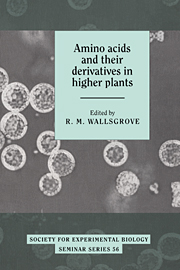Book contents
- Frontmatter
- Contents
- List of contributors
- Preface
- Glutamine synthetase in higher plants: molecular biology meets plant physiology
- Interactions of nitrogen and carbon metabolism: implications of PEP carboxylase and isocitrate dehydrogenase
- The genetics of aspartate derived amino acids in higher plants
- Oxidation of 1-aminocyclopropane-1-carboxylic acid (ACC) in the generation of ethylene by plants
- Regulation of carbon flow through the branched chain amino acid biosynthetic pathway
- Amino acid metabolism and protein deposition in the endosperm of wheat: synthesis of proline via ornithine
- The glycine decarboxylase complex in higher plant mitochondria: structure, function and biogenesis
- Glycine and serine synthesis in non-photosynthetic tissues
- Biogenesis of N-heterocydic amino acids by plants: mechanisms of biological significance
- Toxicity of non-protein amino acids from plants
- Processes involved in glutathione metabolism
- Betaines in higher plants – biosynthesis and role in stress metabolism
- Metabolism and function of polyamines during osmotically induced senescence in oat leaves and protoplasts
- Biosynthesis of cyanogenic glucosides. Elucidation of the pathway and characterization of the cytochromes P-450 involved
- The biosynthesis of glucosinolates in Brassicas
- Biochemical genetics of aliphatic glucosinolates in Brassica and Arabidopsis
- Index
Betaines in higher plants – biosynthesis and role in stress metabolism
Published online by Cambridge University Press: 09 April 2010
- Frontmatter
- Contents
- List of contributors
- Preface
- Glutamine synthetase in higher plants: molecular biology meets plant physiology
- Interactions of nitrogen and carbon metabolism: implications of PEP carboxylase and isocitrate dehydrogenase
- The genetics of aspartate derived amino acids in higher plants
- Oxidation of 1-aminocyclopropane-1-carboxylic acid (ACC) in the generation of ethylene by plants
- Regulation of carbon flow through the branched chain amino acid biosynthetic pathway
- Amino acid metabolism and protein deposition in the endosperm of wheat: synthesis of proline via ornithine
- The glycine decarboxylase complex in higher plant mitochondria: structure, function and biogenesis
- Glycine and serine synthesis in non-photosynthetic tissues
- Biogenesis of N-heterocydic amino acids by plants: mechanisms of biological significance
- Toxicity of non-protein amino acids from plants
- Processes involved in glutathione metabolism
- Betaines in higher plants – biosynthesis and role in stress metabolism
- Metabolism and function of polyamines during osmotically induced senescence in oat leaves and protoplasts
- Biosynthesis of cyanogenic glucosides. Elucidation of the pathway and characterization of the cytochromes P-450 involved
- The biosynthesis of glucosinolates in Brassicas
- Biochemical genetics of aliphatic glucosinolates in Brassica and Arabidopsis
- Index
Summary
Introduction
Betaines are quaternary ammonium compounds (QACs) which contain a carboxylic acid group. They may generally be regarded as fully N-methylated amino or imino acids. While the most commonly encountered betaine (glycinebetaine) is structurally, although not biosynthetically, based on the simplest amino acid, a wide range of aliphatic and aromatic betaines have been described (Fig. 1). These include imino and aromatic amino acid betaines, and compounds such as trigonelline (nicotinic acid betaine) and homostachydrine (pipecolic acid betaine). Related compounds such as choline-O-sulphate and the tertiary sulphonium analogue of β-alaninebetaine, 3-dimethylsulphoniopropionate (DMSP), are also considered in this review since they may have similar physiological roles in some plants.
Although the distribution of betaines in plants is imperfectly known, partly because many taxa have not been thoroughly investigated, it is clear that some families normally contain significant amounts (> 10 mol m-3 plant water) of betaines. In lower plants betaines and related compounds may be incorporated into lipids (Sato, 1992). Recent developments in mass and NMR spectroscopy have greatly facilitated the qualitative and quantitative analysis of betaines. Molecular biology has provided useful tools for the study of regulation of key enzymes of betaine biosynthesis. In vitro studies have clarified the role of betaines as compatible solutes in plants subjected to a variety of stresses. Developments in these areas since the review by Wyn Jones and Storey (1981) will be discussed in detail here, and have also been reviewed by Rhodes and Hanson (1993).
- Type
- Chapter
- Information
- Amino Acids and their Derivatives in Higher Plants , pp. 173 - 204Publisher: Cambridge University PressPrint publication year: 1995
- 53
- Cited by

